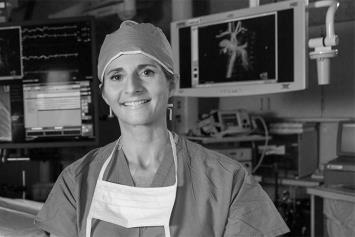Unicameral Bone Cyst
A unicameral bone cyst is an area inside the bone that fills with fluid. It is not cancer (benign), but it can weaken or cause the bone to fracture.
What Is a Unicameral Bone Cyst?
A unicameral bone cyst (UBC) is a benign (not cancerous), fluid-filled pocket in bone. These cysts, also known as simple bone cysts, usually form within a child’s long bones, like the upper arm bone (humerus) and thigh bone (femur).
UBCs usually affect children between 5 and 15 years old. Older children can also be affected.
What Are the Symptoms of a Unicameral Bone Cyst?
Unicameral bone cysts seldom cause symptoms. They may be discovered if a patient has a bone X-ray for an unrelated reason or if pain develops.
Sometimes the cysts can grow, making the bone thin and weaker. Thinning of the bone can cause pain and makes it easier for the bone to break, this is called a pathologic fracture.
How Is a Unicameral Bone Cyst Diagnosed?
Unicameral bone cysts are diagnosed with a medical history, physical exam and imaging tests, which is typically an X-ray.
Advanced imaging techniques, such as magnetic resonance imaging (MRI) and computed tomography (CT), may be needed. This will help to determine the extent of the cyst and distinguish it from other cyst types.
Sometimes, a sample of tissue from the cyst (biopsy) is needed so that it can be analyzed under a microscope by a pathologist to finalize the diagnosis.
How Is a Unicameral Bone Cyst Treated?
The main goal for treatment is to prevent bone fractures. Treatment depends on several factors such as:
- Age, medical history and overall health
- Symptoms and current activity level
- Cyst location and size
- Strength of affected bone
- Likelihood of bone fracture
Treatment can be nonsurgical, surgical or a combination of both.
Nonsurgical treatment involves monitoring the cyst with multiple X-rays over time. If the bone is broken, special slings, braces, or casts are used until the bone heals. Reducing physical activity may be recommended. Cysts can take years to resolve and fractures through cysts up to 6-8 weeks or longer.
Radiology procedures or surgical treatment may be recommended if the cyst is large and painful or there is a high risk of fracture. Several treatment options are available:
- Sclerotherapy: Sclerotherapy is a minimally invasive technique done in Interventional Radiology. Fluid is drained from the cyst, then a substance is injected into the cyst to shrink and destroy it. The radiologist will decide which substance is best. In many cases, IR treatments will need to be done multiple times.
- Steroid injections: For this technique, the cyst is drained and steroids are injected.
- Curettage and grafting: For this procedure, the cyst is drained, then the cyst’s inner lining is scraped out. The empty cavity is then filled in with bone graft
Recovery from surgery usually takes several weeks, with follow-up appointments to monitor healing.
Despite treatment, unicameral bone cysts can recur. Recurrence is more likely the younger a child is when treated. Cysts will stop recurring once a child reaches full growth.



